
Japanese iris
Hanashobu is the name given by the Japanese to iris frequently seen growing on the islands of Japan. The flower also occurs in south-eastern regions of China and southern regions of our Primorye Territory. It may be said without any exaggeration that among all numerous species of the subgenus Limniris the hanashobu is of greatest elegance and beauty. Japanese florists have estimated these merits at true worth and developed over 1000 varieties. This job must be, of course, very time-consuming, since iris are cultivated in Japan for over 500 years. E. Kaempfer, a German scientist, was the first among European botanists who was able to collect hanashobu in the nature. This happened in 1712, i. e. nearly 40 years before Carolus Linneaus suggested his binomial system of botanical nomenclature. That's why E. Kaempfer didn't give hanashobu its rightful botanical name. At a later time K. Thunberg, a Swedish botanist, gave hanashobu the name Iris ensata, but unfortunately this legal binomial name was subsequently erroneously attributed to other iris species, widely distributed in the arid regions of China, Mongolia, Soviet Central Asia and Kazakhstan.

60. 'Letniaja Nochka'br>
In the meantime the most beautiful flower of Japan acquired the name Iris kaempferi Sieb. It was only in 1925 when P. Koidzumi, a Japanese botanist, could finally prove that I. ensata is the right botanical name for hanashobu. Even at present this iris may be met in literature under the two names, and the Japanese varieties are still mentioned as "Iris kaempferi varieties".
The Japanese admire the beauty of their beloved flower and in June when hanashobu come into blooming thousands of peope make hanami, a ritual contemplation of the flower, which envades the soul with joy and delight.
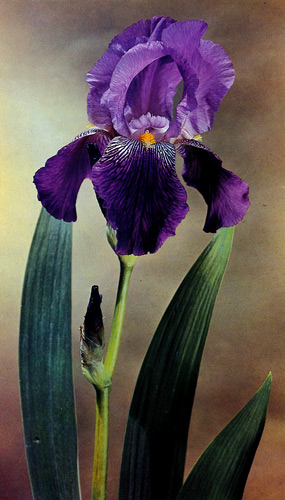
61. 'Zoja Kosmodemianskaja'
The varieties of I. kaempferi are divided in Japan into three classes: Ise, Edo (the old name of Tokyo) and Higo. The first one includes old varieties which are characterized by the same or lower height of the flower stems as the leaves and narrow pendulous perianth segments of the blooms. The number of varieties pertaining to the class Edo is most numerous. The flower stems are rigid and straight and a little taller than the foliage. The blooms are simple or polypetalous with horizontally unrolled or slightly pendent petals. The class Higo mostly includes modern varieties. The blooms are large and massive with folded petals overlapping one another. The core of the bloom, or as the Japanese call it "the heart", consists of three small erect petals and six vigorously developed crests.

62. 'Fialka'
Iris of the Edo and Higo classes have acquired wide popularity in different countries of Western Europe and USA, where many excellent varieties have been developed. Some of them possess better hardiness and may be of definite interest for testing in our country.
The modern varieties of Iris kaempferi are divided into four groups by their flower size: small, with the diameter of a flattened flower below 14 cm, medium, having 14 to 17 cm in diameter, large — up to 20 cm, and very large — of 23 cm or more.
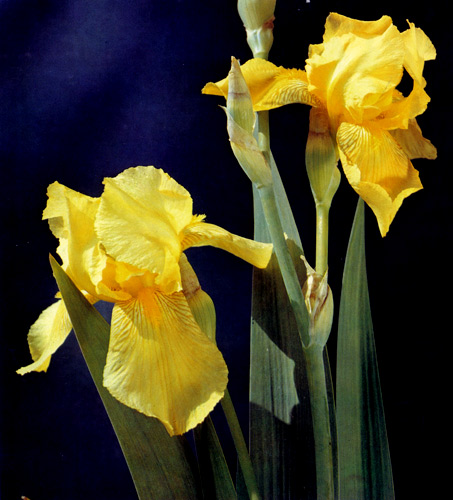
63. 'Zheltyi Velikan'
According to the number and shape of perianth segments, or "petals", the varieties may be simple (which have three pendent segments out of the six), double (with six flat segments) and polypetalous (having nine or more "petals"). The flower stems are 60 to 70 cm high and sometimes as tall as 90 to 100 cm or even more.
The photos kindly presented by Mrs. Seiko Takuma (Fig. 23 to 26) give views of modern iris gardens in Japan.
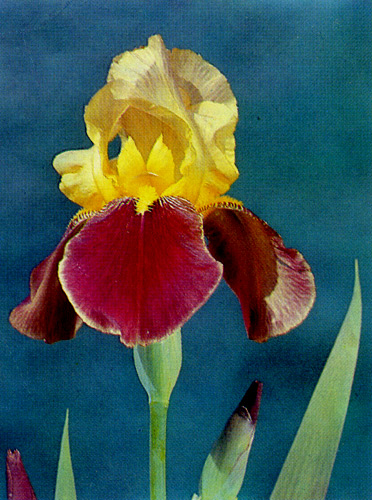
64. 'Pioner'
The varieties of Japanese iris have inherited their biological properties from I. ensata, a typical perennial of wet marine meadows, including such as lack of fragnance. This shortcoming is compensated by its long-flowering habit. Thus, for instance, in Leningrad, at a temperature of +20° to 23 °C the flowers of I. germanica varieties live for 2 or 3 days, wild I. ensata — for 3—5 days and the Japanese iris varieties — for 5—7 days. The love of water attributed to Japanese iris in literature is exaggerated. Although some authors compare its cultivation with rice growing, the iris, in fact, will not grow in water and requires only rich watering in the period of flowering. I. ensata abundantly blooms and produces larger flowers when grown at the banks of ditches with running water. Best results are obtained on sub-acid soils.

65. 'Russkij Sneg'
The wild forms as well as cultivars are easily propagated by division of bushes. The best planting time is early spring and early autumn. The seeds have good germination power and may be sown in autumn or spring. Plants may be left on the same site without deterioration of their decorative merits for 5—7 years or longer. Most dangerous pests are thripses and cutworm grubs.
Japanese iris is cultivated in our country in the Black Sea shore area of the Caucasus. For the first time several hanashobu cultivars were introduced into the Nursery of the АН-Union Research Institute of Plant Industry (Sukhumi) in 1926-1927, and in seven years over 100 varieties were cultivated there. It was the credit of V. A. Alferov, a remarcable pioneer of the Soviet floriculture, who devoted his kind heart and good hands to this job.
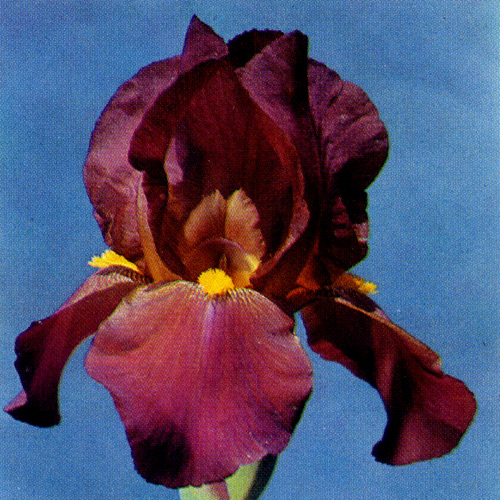
66. 'Orlik'
In the post-war years the collection was replanted in the nursery of the state farm "Yuzhnye Kultury" (Adler), and then, in 1951 G. I. Rodionenko transferred a considerable number of the varieties to Leningrad. An attempt to cultivate the flowers in the open at the latitude of Leningrad was of no success. Positive results were attained when Japanese varieties were pollinated with the pollen of I. ensata brought from Primorye Territory. This has led to developing of the first home-bred hardy hanashobu variety 'Vasilij Alferov'. In Leningrad, it had been grown successfully, producing abundant blooms, unprotected, for 22 years.

67. 'Marina Raskova'
V. M. Nosilov, an amateur gardener, succeeded in growing a number of varieties (some of them of European origin) in the open in Moscow region. He chose elevated sites (artificially created) with sandy-clay soil, in dry summer periods heavily irrigated the plants and two times a month applied fertilizers: ammonium phosphate in turn with potassium carbonate (20 g per 101 of water), with addition to the latter of a pinch of potassium permanganate and boric acid. Part of his plants overwintered without protection. In separate years his irises abundantly flowered.
The most reliable region for cultivation of Japanese iris in the open is the Black Sea shore area of the Caucasus. This work is conducted by T. A. Chochua at the Sukhumi Botanical Garden.
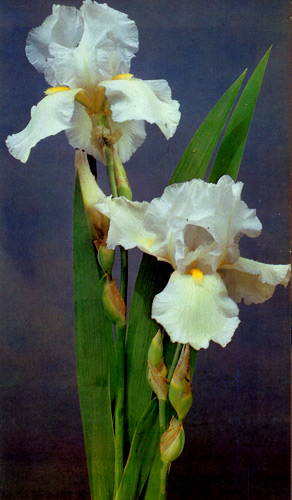
68. 'Sedmoje Nebo'
It is hoped that cultivation of Japanese iris may be successful (with mulch protection for winter) in the southern regions of the Baltic Sea republics, Byelorussia and the Ukraine. Excellent results have given the experiments conducted at the Vladivostok Botanical Garden with the variety 'Vasilij Alferov'. The seedlings develop the flower stems up to 140cm high (compare to 75 cm in Leningrad) and the blooms are 18—20 cm in diameter.
The wild iris itself - I. ensata (I. kaempferi), is by far of great value to floriculturists and landscape gardeners. It can be easily grown from seeds. Bushes of this species, introduced from Primorye Territory into Gornoaltaisk grow there for ten years and are not winterkilled in spite of severe frosts reaching -40°C.
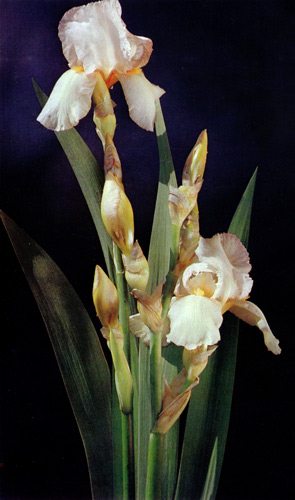
69. 'К Yubileju Iljicha'
|
ПОИСК:
|
© FLOWERLIB.RU 2001–2022
При использовании материалов активная ссылка обязательна:
http://flowerlib.ru/ 'Библиотека по цветоводству'
При использовании материалов активная ссылка обязательна:
http://flowerlib.ru/ 'Библиотека по цветоводству'